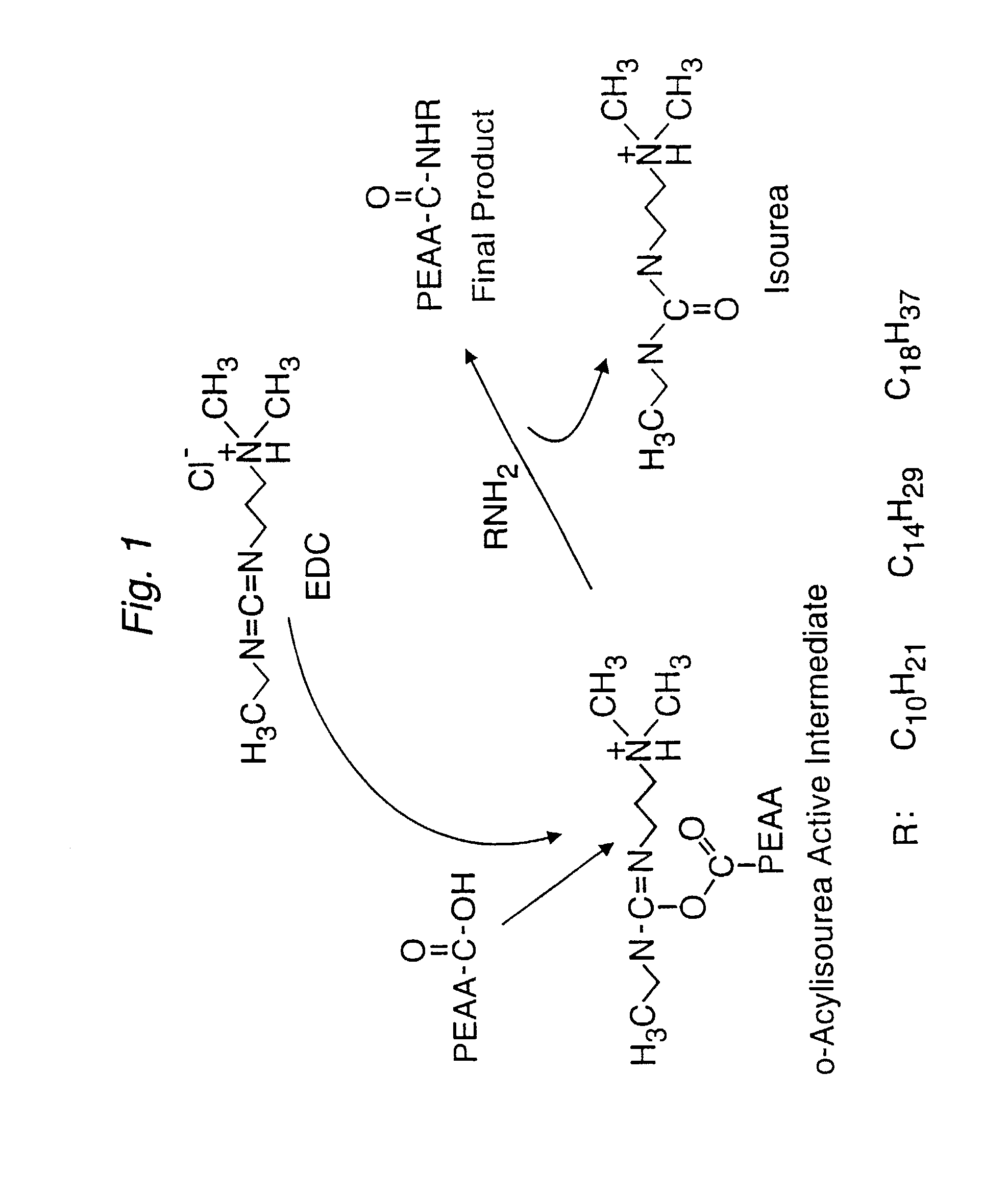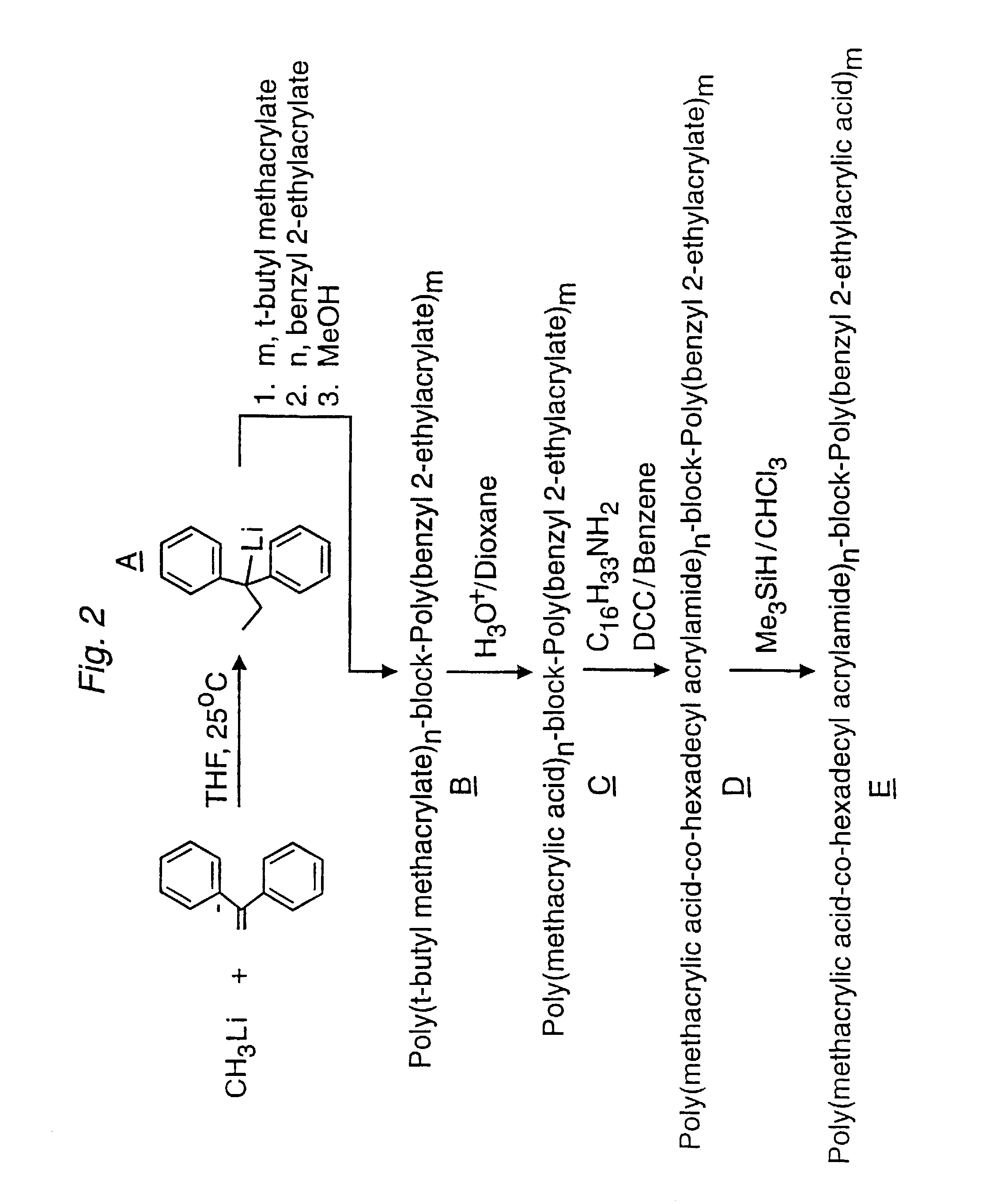Polyanionic polymers which enhance fusogenicity
a polyanionic polymer and fusogenic technology, applied in the field of polyanionic polymers which enhance fusogenicity, can solve the problems of reduced ph sensitivity of the liposome, poor stability of the liposome, and failure to achieve the desired
- Summary
- Abstract
- Description
- Claims
- Application Information
AI Technical Summary
Benefits of technology
Problems solved by technology
Method used
Image
Examples
example 1
[0155]This example illustrates the use of the random point procedure to prepare Lipo-PEAA by EDC-mediated coupling reaction.
[0156]100 mg (100 mmol unit, unit MW=100) of Py-PEAA (polymer molecular weight, 20K, prepared as in example 4) and 3 mmol of 1-Decylamine [CH3(CH2)9NH2] were dissolved in 6 mL of water (pH 7.0). EDC (about 100 mg) was slowly added into the reaction mixture until the amine disappeared. The level of amine, during the reaction, was monitored by TLC (CHCl3:MeOH:triethylamine=8:2:0.2, ninhydrin). The resultant derivative was precipitated by adjusting the pH of the solution from pH 2 to pH 3. The pellets were separated and redissolved in 2 M sodium hydroxide (NaOH) solution, stirred for 30 minutes, and pH was readjusted to pH 2 from pH 3. The suspension mixture was centrifuged, the pellets were separated and washed in water for 3 to 5 times and lyophilized. The yield reached up to 85%.
example 2
[0157]This example illustrates a method for preparing N-terminal-linked Lipo-PEAA by anionic the polymerization reaction. The schematic of the reaction is outlined in FIG. 2.
A. 1,1-Diphenylpropyllithium
[0158]An oven-dried 50 mL round-bottomed flask with a glass stopcock on the side-arm was equipped with a magnetic stirring bar and capped with a rubber septum. The flask was purged three times with purified argon and evacuated each time. Finally it was filled with argon and closed with the glass stopcock. Tetrahydrofuran (THF) 10 mL (Fisher, certified) was stirred over CaH2, degassed, and distilled into a storage flask containing sodium / benzophenone. Fresh THF obtained from this dark-purple solution by distillation and 1,1-diphenylethylene (0.53 mL, 3.0 mmol, 1,1-diphenylethylene (97%, Aldrich Chemical Co.) was stirred over a few chips of potassium metal in a flask for one day at 75° C. in a silicon oil bath with intermittent degassing. A dark blue color developed, indicating the form...
example 3
[0163]This example illustrates a method of synthesis of Benzyl 2-ethylacrylate (BzEA). The schematic of the reaction is illustrated in FIG. 3.
A. 2-ethylacryloyl chloride.
[0164]Thionyl chloride (108 g, 0.9 mol, Thionyl chloride, 99+% Aldrich Chemical Co., used without purification) was placed in a 500 mL double-necked round-bottomed flask equipped with a magnetic stirring bar, a reflux condenser and a dropping funnel. The condenser and funnel were fitted with calcium chloride guard-tubes. 2-ethylacrylic acid (75 g, 0.75 mol, 2-ethylacrylic acid prepared according to the procedure published by Ferritto and Tirrell and used without purification) was placed in the dropping funnel and dripped slowly into the flask. Sulphur dioxide evolved and the liquid darkened considerably. When all of the 2-ethylacrylic acid had been added, the mixture was refluxed for 2 hours. The apparatus was rearranged for distillation and 2-ethylacryloyl chloride boiling at 105–107° C. / 760 mmHg was collected (78 ...
PUM
| Property | Measurement | Unit |
|---|---|---|
| diameter | aaaaa | aaaaa |
| diameter | aaaaa | aaaaa |
| pH | aaaaa | aaaaa |
Abstract
Description
Claims
Application Information
 Login to View More
Login to View More - R&D
- Intellectual Property
- Life Sciences
- Materials
- Tech Scout
- Unparalleled Data Quality
- Higher Quality Content
- 60% Fewer Hallucinations
Browse by: Latest US Patents, China's latest patents, Technical Efficacy Thesaurus, Application Domain, Technology Topic, Popular Technical Reports.
© 2025 PatSnap. All rights reserved.Legal|Privacy policy|Modern Slavery Act Transparency Statement|Sitemap|About US| Contact US: help@patsnap.com



